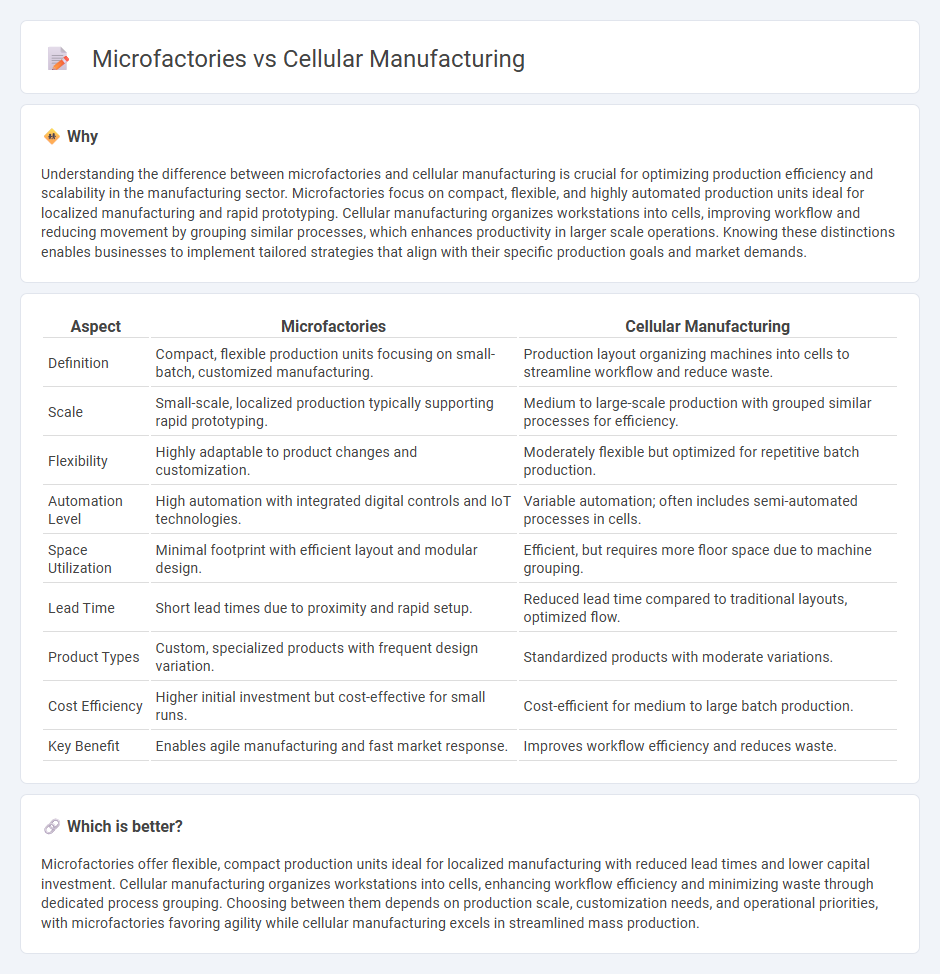
Microfactories prioritize compact, flexible production units designed for rapid customization and reduced footprint, ideal for localized manufacturing. Cellular manufacturing organizes workstations into dedicated cells to streamline workflows, enhance efficiency, and minimize material movement within the production process. Explore the unique advantages and applications of each approach to optimize your manufacturing strategy.
Why it is important
Understanding the difference between microfactories and cellular manufacturing is crucial for optimizing production efficiency and scalability in the manufacturing sector. Microfactories focus on compact, flexible, and highly automated production units ideal for localized manufacturing and rapid prototyping. Cellular manufacturing organizes workstations into cells, improving workflow and reducing movement by grouping similar processes, which enhances productivity in larger scale operations. Knowing these distinctions enables businesses to implement tailored strategies that align with their specific production goals and market demands.
Comparison Table
| Aspect | Microfactories | Cellular Manufacturing |
|---|---|---|
| Definition | Compact, flexible production units focusing on small-batch, customized manufacturing. | Production layout organizing machines into cells to streamline workflow and reduce waste. |
| Scale | Small-scale, localized production typically supporting rapid prototyping. | Medium to large-scale production with grouped similar processes for efficiency. |
| Flexibility | Highly adaptable to product changes and customization. | Moderately flexible but optimized for repetitive batch production. |
| Automation Level | High automation with integrated digital controls and IoT technologies. | Variable automation; often includes semi-automated processes in cells. |
| Space Utilization | Minimal footprint with efficient layout and modular design. | Efficient, but requires more floor space due to machine grouping. |
| Lead Time | Short lead times due to proximity and rapid setup. | Reduced lead time compared to traditional layouts, optimized flow. |
| Product Types | Custom, specialized products with frequent design variation. | Standardized products with moderate variations. |
| Cost Efficiency | Higher initial investment but cost-effective for small runs. | Cost-efficient for medium to large batch production. |
| Key Benefit | Enables agile manufacturing and fast market response. | Improves workflow efficiency and reduces waste. |
Which is better?
Microfactories offer flexible, compact production units ideal for localized manufacturing with reduced lead times and lower capital investment. Cellular manufacturing organizes workstations into cells, enhancing workflow efficiency and minimizing waste through dedicated process grouping. Choosing between them depends on production scale, customization needs, and operational priorities, with microfactories favoring agility while cellular manufacturing excels in streamlined mass production.
Connection
Microfactories and cellular manufacturing both focus on enhancing production efficiency through compact, modular setups that streamline workflows and reduce waste. Cellular manufacturing organizes workstations into small, self-contained units that perform sequential operations, closely aligning with microfactories' emphasis on flexible, scalable production spaces. This synergy enables faster response times, improved product customization, and optimized resource utilization in modern manufacturing environments.
Key Terms
Work Cells
Work cells in cellular manufacturing organize machines and operators into compact, efficient units dedicated to specific product families, enabling smooth workflow and reduced transit times. Microfactories leverage similarly modular work cells but emphasize scalability, flexibility, and advanced automation to accommodate rapid production changes and diverse product lines. Explore more about how these work cell designs drive productivity and innovation in modern manufacturing environments.
Scalability
Cellular manufacturing organizes workstations into small, autonomous units that streamline production and enhance scalability by minimizing waste and improving workflow efficiency. Microfactories leverage compact, tech-integrated spaces designed for rapid reconfiguration, enabling businesses to scale operations quickly and respond to market demands with agility. Explore how these innovative manufacturing models can transform your production scalability strategies.
Flexibility
Cellular manufacturing arranges workstations in a sequence to enhance workflow efficiency, providing moderate flexibility suitable for batch production. Microfactories emphasize high adaptability with modular designs and advanced automation, allowing rapid product customization and scaling. Explore how these systems impact production agility and cost-effectiveness.
Source and External Links
Cellular Manufacturing: A Comprehensive Guide - Deskera - Cellular manufacturing is a production system that organizes processes into unified manufacturing cells to enhance efficiency, involving steps like assessing the production environment, designing cells, and monitoring performance.
Cellular manufacturing - Wikipedia - Cellular manufacturing is a lean production approach that arranges machines into cells to produce parts or products in a smooth flow, reducing waste and inventory while improving flexibility and quality.
What Is Cellular Manufacturing? - MRPeasy - Cellular manufacturing arranges workstations and equipment in a sequence to optimize continuous production flow, with self-sufficient cells where workers are cross-trained, improving communication, lead times, and reducing waste.
 dowidth.com
dowidth.com